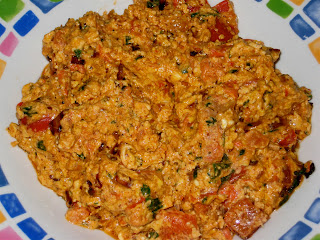
Ingredients:
1.5 cups sifted, all-purpose flour
2.5 teaspoons baking powder*
0.75 teaspoons salt
1 large egg
1.25 cups buttermilk
3 tablespoons melted butter
* The original recipe says to use 0.5 teaspoons baking soda instead of the baking powder when buttermilk is used in place of regular milk, but I used baking powder, and the pancakes came out just fine.
Sift the flour, baking powder, and salt together in a big bowl. Mix the egg, buttermilk, and butter together separately. Then pour the wet mixture into the dry mixture. Stir until the dry mixture is completely covered (i.e., you can't see any more flour), but do NOT stir until smooth. The batter should be somewhat lumpy.
At this point, you can cover the mixture and refrigerate it until you need it, or you can make the pancakes immediately.
When I make the pancakes, I always make them in two pans at once, so they're done faster. Have on hand a big plate to put the pancakes on and a clean towel to cover them, so you can keep them warm while you're cooking the rest. You'll also need a good spatula and a ladle or large spoon for the batter.
If you have cast-iron griddles, those are definitely the best pans to use, but if you don't have any, just use the sturdiest pans you can fine. Heat the two pans on two burners. To test if the pans are hot enough, sprinkle a little water on them - the water droplets should skip across the surface of the pan when it's ready.
When the pans are hot, spoon batter into the center of each pan in a small circle. If necessary, use the spatula to flatten the pancakes out a bit, as the buttermilk makes them quite thick. When bubbles appear on the tops of the pancakes, they are about ready to be flipped. Check by lifting the edges of the pancake with the spatula (it's also good to do this periodically anyway to keep the pancakes from sticking to the pan).
When the bottom of the pancake is golden brown, flip it with the spatula and cook until the other side is also golden brown. Then flip the pancake onto the plate, cover it with a towel, and pour more batter into the pan.
You may need to adjust the heat of the burners as you go. If the pancakes are getting dark too quickly, turn it down, and if they're taking too long to cook, turn it up.
When all the batter has been used up, serve the pancakes warm. The classic way to eat them is with maple syrup, which I love, but I also like to eat them with butter and jam. Feel free to add whatever toppings you like - sour cream, fruit, etc.














